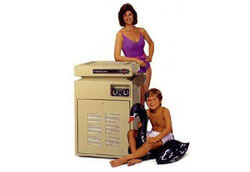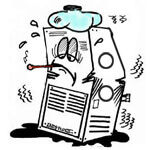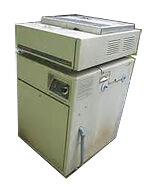How To Repair My Laars Heater
 Swimming pool heaters are great, they make the h2o warm and extend the puddle flavor on both ends. They also tin be the most ornery piece of equipment around a pool.
Swimming pool heaters are great, they make the h2o warm and extend the puddle flavor on both ends. They also tin be the most ornery piece of equipment around a pool.
What practise you lot do when the heater will not burn-off, leaving you with a common cold swimming puddle? Today we cover the most mutual reasons why a pool heater will not offset up in this heater troubleshooting article.

The most common issue when a swimming pool heater won't heat is also the simplest i, a dirty swimming pool filter. They say that upwards to seventy% of all 'My heater won't heat' service calls are due to depression h2o flow. The heater has a force per unit area switch and an internal bypass, to ensure the correct amount of incoming water menstruum, before it volition plough on. A dirty pool filter or pump basket will restrict the water flow, so e'er ensure that everything is clean and all valves are open up. Check that your filter pressure gauge is normal, that'south a good indicator and proxy for menstruation rates.
At that place are several types of gas pool heaters; for this commodity, nosotros are focused on gas and propane pool heaters. For more than advanced trouble shooting on a pool heater you volition demand a power meter or multi-meter to bank check the current as it flows through the diverse heater components. "The problem lies where the power dies…" All swimming pool heaters have what we refer to as the command loop. This is a elementary circuit (retrieve school science off-white, with a battery, switch, and calorie-free) that goes through a number of safety controls, or checks before the heater is allowed to burn-off. Only if all the safety switches are enabled will the heater turn on, and begin to heat the water. Every bit stated above, the well-nigh common effect is water flow, merely let's kickoff from the beginning.
 All heater command circuits run on electricity. Your heater will have one of two ability sources, line voltage from a billow box, timeclock or outlet, or milli-voltage that your heater makes on its own. If you lot have a standing, always-on airplane pilot light that is manually lit, you take a millivolt pool heater. The estrus from the pilot flame heats 2 unlike metals in a bulb (thermocouple or pilot generator) side by side to the pilot to produce the milli-voltage (less than 1 volt) to power the gas valve and control circuit.The pilot generator must be positioned properly, immersed in the airplane pilot flame, to heat upwards sufficiently to create the small corporeality of voltage.
All heater command circuits run on electricity. Your heater will have one of two ability sources, line voltage from a billow box, timeclock or outlet, or milli-voltage that your heater makes on its own. If you lot have a standing, always-on airplane pilot light that is manually lit, you take a millivolt pool heater. The estrus from the pilot flame heats 2 unlike metals in a bulb (thermocouple or pilot generator) side by side to the pilot to produce the milli-voltage (less than 1 volt) to power the gas valve and control circuit.The pilot generator must be positioned properly, immersed in the airplane pilot flame, to heat upwards sufficiently to create the small corporeality of voltage.
These days, millivolt pool heaters take lost ground to electronic pool heaters. Electronic pool heaters are supplied with power that runs through a transformer equally it enters the heater. The reduced voltage, normally 24 volts, is so sent into a control module, aka IID or Fenwal. This gray box sends power to the control circuit. In one case you take established you lot are getting power through the transformer (24 volts) or from the Pilot Generator, aka thermopile, (400-600 mv), and then nosotros "follow" the power with our multi-meter, looking for a Voltage Drib at any 1 of the components in the heater.
"The Trouble Lies Where the Power Dies"
You lot will need to follow the power to each safety switch. The first one is the pressure switch. This switch makes certain enough water is flowing through the unit before information technology will allow the pool heater turn on. This means you must have the pump on and a clean filter for this switch to close and let voltage to laissez passer through. With a multi-meter, you should get voltage reading through the force per unit area switch if it'due south working right. Y'all can also 'jump-out' the pressure switch, by using a bent wire or needle olfactory organ pliers to touch both contacts at the same time, allowing the electric current to menstruum around or bypass the switch. This should exist washed only for testing purposes, do not operate your heater with the pressure switch bypassed.
 A give-and-take on featherbed valves. Most puddle heaters have an internal featherbed valve that is located inside of the front header of the heater (where the pipes become in and out). It'southward not really a 'valve' like you have to control your skimmer and master drain, but a spring loaded door that allows backlog water pumped into the heater to return, immediately out of the heater, without being heated. This is necessary to keep the optimum catamenia of water through the heat exchanger. Besides much h2o flow tin cause condensation, erosion, and poor operation. If you take a loftier menses puddle pump, yous may desire to consider installing an external bypass, outside of the heater. This is a plumbing manifold that diverts a percentage of h2o "effectually" the heater, bypassing it back to the pool.
A give-and-take on featherbed valves. Most puddle heaters have an internal featherbed valve that is located inside of the front header of the heater (where the pipes become in and out). It'southward not really a 'valve' like you have to control your skimmer and master drain, but a spring loaded door that allows backlog water pumped into the heater to return, immediately out of the heater, without being heated. This is necessary to keep the optimum catamenia of water through the heat exchanger. Besides much h2o flow tin cause condensation, erosion, and poor operation. If you take a loftier menses puddle pump, yous may desire to consider installing an external bypass, outside of the heater. This is a plumbing manifold that diverts a percentage of h2o "effectually" the heater, bypassing it back to the pool.
The next finish for the power is to the high limit switches. Most heaters accept two high limits, usually located side-past-side on the outlet manifold, a 'depression' high limit usually prepare to 135° and a high-loftier limit prepare to 150°. These are sensors designed to turn the heater off if the h2o inside gets too hot. They usually volition reset themselves if tripped but practice go bad from fourth dimension to fourth dimension. If your high limits become bad, there could exist an issue with the bypass valve in the in/out header causing the unit to overheat, from allowing likewise much water to bypass the heat exchanger.

From the loftier limits the power so goes to the thermostat. This is what controls the heater and lets the unit know what temperature to heat up to. When testing your heater, plough the thermostat all the way up. You should discover voltage going in and out of this if the probe that goes to the in/out header is working properly.
 The adjacent safety switch inline is the fusible link, aka thermal fuse. These sense heat well-nigh the gas valve. If the flame from the burners comes into the front end of the heater (flame roll out), a small-scale wax pellet inside the link melts, breaking the circuit. The fusible link cannot be reset and if yours has failed, the heater may have a blockage of the burners or improper venting / exhaust from the meridian of the heater. Exist sure to check all possible causes for this, as it could bespeak a hazardous state of affairs.
The adjacent safety switch inline is the fusible link, aka thermal fuse. These sense heat well-nigh the gas valve. If the flame from the burners comes into the front end of the heater (flame roll out), a small-scale wax pellet inside the link melts, breaking the circuit. The fusible link cannot be reset and if yours has failed, the heater may have a blockage of the burners or improper venting / exhaust from the meridian of the heater. Exist sure to check all possible causes for this, as it could bespeak a hazardous state of affairs.
Next the electric goes to the gas valve and, depending on if y'all have a 24 volt electronic heater or a millivolt heater, the power then goes to an electrical ignition box or IID that volition low-cal the airplane pilot. Heater gas valves are less reliable than they should exist, and tin can get stuck closed, become gunked up, or can short-out internally. If all of your prophylactic circuits check out OK, but gas does not seem to be released to the burners, it could be a failed gas valve.
 Checking the safety circuit is a good place to showtime, you should get power into and out of every safety switch in gild for the heater to come on. On the newer electronic heaters, many accept a circuit board that will give you an error code telling yous what switch is not working keep the heater from coming on. Bank check in your owners manual for a listing of fault codes.
Checking the safety circuit is a good place to showtime, you should get power into and out of every safety switch in gild for the heater to come on. On the newer electronic heaters, many accept a circuit board that will give you an error code telling yous what switch is not working keep the heater from coming on. Bank check in your owners manual for a listing of fault codes.
 Of course a circuit board could be the cause of your heater troubles. Despite improvements over the final 20 years, circuitry nonetheless can have trouble with wet and insects, or irregular voltage. If yous accept a degree in electrical technology, y'all may be able to find the faulty resister, relay or capacitor on the board, or if not, you can supercede with new.
Of course a circuit board could be the cause of your heater troubles. Despite improvements over the final 20 years, circuitry nonetheless can have trouble with wet and insects, or irregular voltage. If yous accept a degree in electrical technology, y'all may be able to find the faulty resister, relay or capacitor on the board, or if not, you can supercede with new.
Exist sure to be careful working around gas pool heaters as they can be deadly dangerous! Practise not bypass safe circuits to operate the heater, or you could be creating a very plush future repair. For more than info on heaters and how they work, please bank check out our pool heater info pages.
Happy Heating!

Rob Cox
In The Swim Blog Editor
How To Repair My Laars Heater,
Source: https://blog.intheswim.com/pool-heater-repair-my-pool-heater-wont-start/
Posted by: mcraeopoetinat.blogspot.com


0 Response to "How To Repair My Laars Heater"
Post a Comment